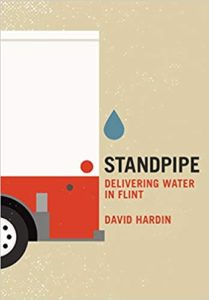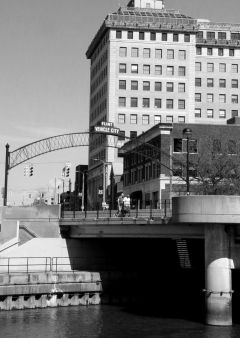Book Review: “Standpipe–Delivering Water to Flint” an ode to one man’s witness of troubled times
By Jan Worth-Nelson
I was prepared to dislike and resent David Hardin’s new book, Standpipe: Delivering Water in Flint. I expected to rail against it and pronounce my irritation with the tedious audacity of yet another out-of-towner carpetbagging into town and making something of the Flint Water Crisis for their own aggrandizement.
Hardin, David Standpipe: Delivering Water in Flint. Cleveland: Belt Publishing, 2021.
But something happened, on about the third page. First, a deep sadness washed over me. And then, I started to feel reluctant respect and something like agape love for Hardin – a retired Detroit public school teacher, artist, and poet.
A poet. That matters. Isn’t it often the poets among us who somehow manage to touch our most vulnerable places? Sometimes our broken parts elude healing through the usual parades of facts and political arguments; poets open us up to truths of the heart, where healing begins. He pulls it off, I contend, with humility. It’s a deeply personal account of one man’s story and makes no claims to cover the whole crisis itself or speak for its victims.
Start with the basics: In February, 2016, a late middle-aged white man from a mostly white Detroit suburb becomes a Red Cross volunteer and is assigned to deliver water in Flint.

He is grieving his mother’s death, craving reconciliation from an estrangement that had eluded him for decades.
He gets the job of driving an ERV (Emergency Response Vehicle) loaded with pallets of water, filters, test kits and pamphlets. A partner – a rotating sequence of mostly young white AmeriCorps volunteers— rides shotgun, and the pair deliver to people who can’t make it to the official water distribution sites set up around the city. Most of the volunteers don’t know the city and are guided by a Garmin and a “hot sheet” with the day’s addresses.
Hardin’s 82 chapters of one or two pages each – many operating like prose poems – alternate about half and half with vignettes of his Flint encounters and memories and introspections about his mother as she declined and died. The episodes are not chronological – rather, they drop into the narrative in the way one might talk to a therapist: one thing leads to another.
He continues volunteering several days a week through July.
He writes that Flint transformed him. He is modest about his claims.
“Had I not gone,” he writes in his first chapter, “life would have continued on its familiar arc. Flint wouldn’t have missed me in the slightest.”
He says he was a deployed to “a city for which I have no particular affinity, nor harbor any bad blood. Just another town through which I’ve passed, free of claim.” But he sides with the underdog, and as the details of the crisis unfold to him, he considers the “casual racism” he grew up with and is “stoked with righteous rage,” as he sees first hand the result, not just of the water crisis, but “ decades of insult on top of injury, a people asked to pay the price, once again, for this nation’s original sin.”
The volunteers are instructed not to linger at their delivery destinations – to get the water out and go quickly to the next spot—making Hardin’s contacts necessarily brief—each visit a capsule, a nutshell, a one-act play.
At a “forlorn and desperate looking” block on the west side of Dort Highway, he notes “a few boarded-up houses, parked cars in various states of disrepair, yards returning to meadow, baking planes of puckered shingles, cracked tongues of driveways speckled with empty water bottles, a street at once depopulated in aspect, but alive with flickers of life – a green hanging plant, a small pink bicycle tipped on its side, hum of window AC.”
At another, a large woman “flushed from the effort of having descended the stairs,” tells him she has just had hip surgery; her two sons, one autistic, are asleep upstairs, and she hasn’t had a delivery in more than a week. Hardin and his partner stack the cases in the hallway, “leaving only a narrow pathway disappearing into gloom…water-frescoed plaster sags overhead….” He can’t imagine how she and her sons will manage.
“On the way out, I wish her luck, remind her to have a nice day. It would be impossible to feel more ineffectual, a sense of fecklessness pooling about me as if my pants had suddenly dropped to the floor to the tune of Stardust…” Outside, in soft morning light, “a hallelujah chorus of forsythia erupts, yellow and shameless, serenading me loudly, mercilessly, as I slink back to the ERV.”
There are many other examples: the beat-up front porches and rickety stairs; the “rheumy eyed” old men wandering the street in broad daylight; the crazies, one shouting at Hardin’s young female partner for a cure for too much masturbation; people surrounding the ERV to get more water, even when there already are dangerously heavy piles on shaky floorboards; the inevitable pitbulls and rotweilers; the children, some apparently caring for other children in dark, barely furnished rooms…
And…”Who is to blame, goddammit? Men in power, the clockworks of the universe? If there’s a god in heaven, and so forth…
I confess I’m still not quite sure how Flint’s miseries of 2016 effected the transformation of Hardin’s thorny relationship with his mother. But I found both parts of his narrative – the trips to Flint, the remembered deterioration of his mother and her death – compelling and authentic.
He is on a journey, he says, to become “a good man.’ In a summarizing chapter where he poignantly examines what that might mean—in the emerging aftermath of the displacement of his rage and grief about his mother, he says he finds release in the physical act of delivering a simple, needed essential of life: water. Whether Hardin’s account of this existential quest for meaning works for a reader–especially a Flint reader who could not drive away from the crisis any day or any year — is sure to be an individual matter.
The point, a central one to me, is that the Flint water crisis was (and is) both a collective trauma, experienced by a whole community, majority poor and black, but also an individual experience, mediated in a thousand different ways. That has made it confusing and at times hard to talk about.
Hardin’s unvarnished accretion of the nouns and verbs of Flint life as he urgently plies his poet’s trade made me feel things I did not want to feel — made me remember how bad things were in Flint in that becursed year, one of many to come, especially in swathes of the most troubled parts of the city north of the Flint River.
I wanted to say, this is not all that we are. But it surely is part of the truth of who we are: a hurtful truth, perhaps many truths which add up to some rough conclusions about the hard lives of our citizens.
The weekend I read this book and started writing about it, a band of about 50 stalwart water activists, many of whom I have known for years in writing stories for East Village Magazine, met in the potholed parking lot of the old Farmers’ Market to observe the seventh anniversary of the crisis that brought Hardin to his transformation.
It was, of course, COVID-friendly, many people staying in their cars facing the “Jazz on the Move” trailer plastered with rally posters and flying the Stars and Stripes and the Michigan flag. The principals – pastors, long-suffering activists who have never stopped fighting for the poor, fighting for justice — walked around in masks, mourned the dead, and made brave pronouncements. A City Council member sang along with “Wade in the Water.” Later they played “Amazing Grace” and there was a moment of silence. A plan to send seven white lanterns mostly worked—one skidded across the parking lot, finally lifting up but getting stuck in the trees. A t-shirt much in evidence stood out: it said, “Flint is Still Broken.”
We wish it wasn’t. Many good people are trying to fix it – have been trying to fix it for years, through sometimes unimaginably trying circumstances. The exhaustion, in some quarters, is palpable.
So it is matter of respect for those faithful and weary warriors to say that this small book offers only how the Flint water crisis affected one man and interacted with the rest of his life. But while it does not solve the big problems that remain in the city he quietly got to know for a few wrenching months, perhaps it is capable of touching our hearts and minds through Hardin’s truthful witness.
EVM Consulting Editor Jan Worth-Nelson can be reached at janworth1118@gmail.com.


You must be logged in to post a comment.